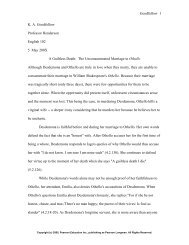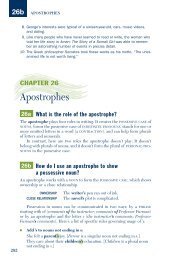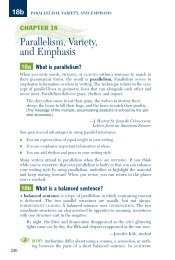chapter 3 - Pearson Learning Solutions
chapter 3 - Pearson Learning Solutions
chapter 3 - Pearson Learning Solutions
You also want an ePaper? Increase the reach of your titles
YUMPU automatically turns print PDFs into web optimized ePapers that Google loves.
2009934667<br />
CULTURALLY SPEAKING<br />
Waving Hello and Good-bye<br />
In most European countries, the accepted way to wave hello and good-bye is palm<br />
out, hand and arm stationary, fingers wagging up and down. The common American<br />
waving of hello or goodbye means no—except in Greece, where it is an insult.<br />
Source: worldcitizensguide.org<br />
in a Mexico City client’s office, may decide to leave the office, feeling that she is being<br />
ignored and that the client’s lateness is a sign of lack of interest in the business deal.<br />
But the Mexican client may not consider himself at all tardy and may be totally<br />
confused by the European American’s quick exit.<br />
European Americans engaged in business dealings with Arabs, for example,<br />
should understand and adhere to their customs of hospitality so as to be successful.<br />
The initial meeting with an Arab businessperson is typically devoted to fact<br />
finding. No commitments are implied or made, but the initial session is usually<br />
lengthy and thorough. Based on their pattern of working quickly so as not to waste<br />
time, European Americans often feel that the process is tedious. The next meeting<br />
is taken up with additional rituals. It is not unusual for a business deal to take as<br />
long as thirty days to complete.<br />
Gesture patterns, which have verbal meanings, also vary. For instance, the<br />
thumb-and-forefinger-in-a-circle gesture means “okay” in the United States. In<br />
France or Belgium, however, it means the recipient is worth zero. The same gesture<br />
in Greece and Turkey is a sexual invitation. Similarly, an index finger tapping to the<br />
temple with the other fingers curled against the palm usually means “You’re smart”<br />
in the United States whereas it communicates “You’re stupid” in most of Europe. 20<br />
The use of space also varies widely around the world. Arabs, South Americans,<br />
and Eastern Europeans generally favor close conversational encounters, which<br />
may make European Americans feel somewhat uncomfortable and Germans and<br />
Scandinavians totally uncomfortable.<br />
We tend to read nonverbal signs on the basis of our own personal background<br />
and experiences, and we assume that others share the same interpretations—an<br />
assumption that can be misleading, even dangerous. We must remember that in<br />
all forms of communication, an understanding of the receiver is necessary. And,<br />
as if matters were not complicated enough, we also must be aware that although<br />
cultural patterns are reported to be persistent, not all the people within a given<br />
culture share identical patterns.<br />
Emotional Influences on<br />
Nonverbal Communication<br />
Chapter 3 Nonverbal Communication 61<br />
Emotions have a direct effect on the size of people’s personal territory and their<br />
resulting nonverbal responses. When people are insecure, they tend to avoid closeness.<br />
People who are emotionally upset may even become violent if someone<br />
invades their territory. Again, these are representative of the basic human needs<br />
and what happens when needs are not being satisfied.<br />
When people are upset, their bodies may become rigid. For example, many<br />
people who are nervous about public speaking report that their throats tighten<br />
Communicating: A Social and Career Focus, Tenth Edition, by Roy M. Berko, Andrew D. Wolvin, and Darlyn R. Wolvin. Published by Allyn & Bacon.<br />
Copyright © 2007 by <strong>Pearson</strong> Education, Inc.
















